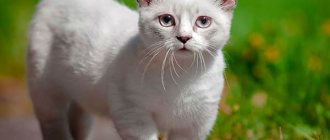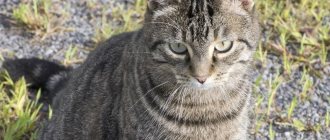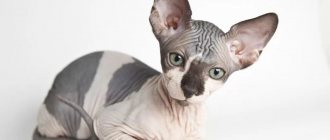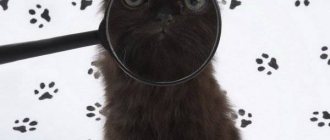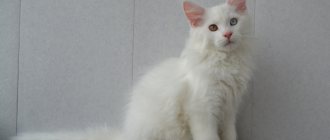Origin story
Officially, the year of birth of the Laperm breed is considered to be 1982: when a hairless kitten was born on an ordinary farm in the American town of Dallas.
His mother was a simple mongrel cat, his father was a “visiting” cat-traveler, so the birth of a baby without hair, but with bluish spots on the skin, was treated rather indifferently: what to take from the little freak? Let him live. However, after a couple of months, the owners were pleasantly surprised: the kitten’s body was covered with unusually soft to the touch, and most importantly, curly fur of a beautiful shade. Naturally, they named the baby Curly.
Over time, the number of curly-haired cats increased and the owners began to wonder: what’s the matter? A couple of cats were taken to a local exhibition and shown to specialists, and they rendered a verdict: they had never seen such an amazing mutation, which means that a new, unprecedented breed had appeared. And it should be developed further.
Richard and Linda Coel, the owners, did not put the matter on hold. It turned out that the curly gene is the dominant gene, and it is transmitted both through the mother and through the father. This greatly simplified the breeding task. The first nursery was opened, several exhibitions were held, and work began to stabilize the breed. The crossbreeding involved Manx cats, Siamese cats, and domestic mongrel cats of similar build.
In 1997, a standard was drawn up, and gradually the breed was recognized one by one by major world felinological organizations: TICA in 2002, CFA in 2008, ACFA in 2011, ACFA in 2011. In 2021, the breed became closed, i.e. cats are no longer allowed to be crossed with other breeds.
The name of the breed consists of the English “perm” - perm and the French article “la”.
Character
Laperms are described as sociable animals that love human attention. Cats respond to him with tenderness and affection. Cats consider their owner's lap to be the best place to rest. Where they happily accept stroking and scratching.
Being in bliss is not the only thing cats do. They are smart and intelligent, curious and playful. They have not lost at all the professionalism of their ancestors in catching mice. In addition, the nature of the Laperm breed includes a good attitude towards water. They can frolic in the rain, trying to catch large drops.
Standards
Laperm are quite large cats. Females are usually smaller than males and weigh 2-2.5 kg. Males can exceed the 5 kg bar. They are proportionally built, muscular, but at the same time elegant and graceful.
| Standard | Description |
| Head | The skull is wedge-shaped, rounded. The whisker pads are dense, round, and the whiskers are long. The chin is strong, the forehead is flat. |
| Ears | Cup-shaped, spaced far apart, abundantly pubescent. If the coat is long, lush tassels at the ends are allowed. |
| Eyes | Not very big, but expressive. When a cat is calm, its eyes are almond-shaped and expressive; when frightened, they become round, like coins. The color of the iris can be any and is not tied to the shade of the coat. |
| Torso | Medium in size, finely boned. The back is slightly higher than the shoulder girdle. |
| Limbs | Long, slender, the front ones are slightly shorter than the rear ones. The paws are rounded and flattened. |
| Tail | Equal to the length of the body, tapering towards the tip. |
Special mention should be made about wool. Laperms are divided into short-haired and long-haired.
The coat of short-haired cats is airy, light and wavy, but in some individuals it can be harsh. It lies in large waves, there is often a “collar” in the neck area, and tassels on the ears, but their absence is not considered a defect. The tail looks like a bottle brush.
Long-haired individuals have disheveled fur, a soft “collar” is always present on the neck, and the tail resembles a plume. It can be either curly or wavy, it can change density depending on the season, but it should always be airy and light. This is easy to check: if you blow on it, it moves apart. Hangs along the spine.
Laperm kittens are born hairless, and curls begin to appear at about 2 months of age.
Significant deficiencies for which points will be deducted in competitions:
- Tiger pattern on the coat, spots;
- Different wool texture.
An animal is removed from the competition if it has:
- Strabismus;
- Paws that are too short or massive;
- The body is stocky and large;
- There are extra fingers;
- The coat is not curly or wavy, but straight and thick;
- Cryptorchidism;
- The tail is short or too long, with bumps or knots visible on it;
- Bald spots and bald patches are clearly visible on the fur of adult cats (over a year old).
Do you want to buy a curly-haired kitten? Contact the nursery. When buying a baby secondhand, you risk running into scammers. The cost of one kitten is at least 400 dollars. A healthy kitten, raised in love, has clean and clear eyes, ears and mouth, it does not run wild and does not shy away from human hands. Pedigree is required if you are planning breeding: the data is printed on the organizational form and secured by the signature of the manager. A veterinary passport is also required, which must contain information about vaccinations.
General characteristics of the breed
What do cats of this breed look like? What is their character?
Appearance
LaPerm cats have a slender and strong body of medium size, usually larger than females. Their wonderful coat consists of curls curled into rings and spirals, and directed from the ears of the cat to the tail. It has a silky texture that varies with age and varies depending on gender.
Six really looks like a curly fur coat and feels like soft mohair. True, in some short-haired LaPerms it can be coarse with elastic hairs. The undercoat is sparse, and the coat, light and airy, does not adhere tightly to the body.
At exhibitions, judges, in order to assess its quality and condition, blow on the cats' hairs, which should flutter freely. Laperm kittens are rarely born with the same curls as their parents; more often they are born straight-haired or bald. But later, almost all cats develop curls, although some cats still have straight hair.
Many babies, born with curly hair, soon lose their hair, even to the point of baldness. Don't be alarmed, later it will grow back even thicker than before. It is difficult to predict what kind of fur an adult cat will have until the kitten is more than 4 months old. Therefore, it is not recommended to buy a show-class cat before this age.
LaPerm cats have particularly beautiful hair on their tails that strongly resembles a plume. The head of LaPerm cats is wedge-shaped, they have a round muzzle, a short and snub nose, and high cheekbones. Cats' ears are large, slightly drooping and widely spaced. LaPerm's large eyes are almond-shaped.
LaPerm cats have no particular color and can mate with domestic cats of any color to produce offspring.
The weight of these animals is 2.5-4 kg. They mature for quite a long time: up to 2 years.
Character
By nature, LaPerm cats are very friendly, and they can serve as companions for both adults and children. Their friendliness is also clearly manifested in relation to other pets, including dogs.
This is a curious breed of cat. They not only love to participate in the affairs of their owner and study the environment in which they find themselves, but also watch the images on TV with interest. This is a sociable breed, so they find loneliness difficult.
A laperm kitten must be taught from an early age to communicate with other people, then it will not be afraid of your friends, and they will be able to play with it freely. Kittens quickly get used to children and enjoy participating in their fun. The main thing is to make sure that your kids do not offend them, for example, by pulling their tail or curls.
They differ from other breeds in that they love a person not for a “full bowl”: communication and love are more important for them. Laperm cats are very sensitive to their master's caresses and attentive to human speech.
They themselves are not talkative, but if something does not suit them, they can make loud “ma-u” sounds. LaPerm cats are freedom-loving, so they prefer to live in a private house with a garden plot and a spacious yard. If the cat lives in a small apartment, he must often be taken for walks closer to fresh air. The ancestors of this breed were excellent hunters, so they still have the hunting instinct.
Colors
Experts allow any colors: both pure and in combination. The most common are the following:
- Black (nose and paw pads are also jet black);
- White (pink paws and nose);
- Red (pink nose and paws, ticking not desirable);
- Ivory (paw pads and nose are colored cream);
- Brown (both light and dark chocolate shade).
In the photo there are cats of the LaPerm breed of popular colors: red, black, white.
The total number of colors in the standard is 30. Hereditary: tabby and tortoiseshell.
Feeding
Cats of the LaPerm breed are expensive and are not yet very common, but it is already known that they are not at all picky about food and happily eat the same food as other, less refined breeds. With all this, it is worth remembering that food must be balanced, high quality and fresh.
And Lapermas don’t need any special delicacies at all. In infancy, the best food for them is mother's milk. If suddenly, for some reason, the mother cannot provide them with food, it is recommended to buy special mixtures in a specialized store.
Never feed small cats cow's milk! After feeding your little kitten, be sure to massage its tummy with a piece of cloth soaked in milk - this will improve digestion.
First feeding of kittens:
- boiled chicken yolk;
- chopped boiled beef meat;
- minced chicken
Only when cats are well strengthened can you begin to accustom them to adult food.
Please remember that it is contraindicated for LaPerm cats to include garlic, onions, chocolate, grapes, alcohol, sugar and food sweeteners in their diet, as do many other cat breeds. Never overfeed your pets to avoid the problem of obesity.
Character and behavior
This wonderful curly ball is incredibly kind and affectionate. He experiences the kindest emotions towards a person, does not hesitate to demonstrate his affection: he strives to climb onto his owner’s shoulder and lick his nose and ears, touch his face with his paws, look into his eyes. The cat’s favorite place is the shoulders and chest of a person, and in the hands the cat feels absolutely protected.
Name the cat who always wanted to live together
BasilioLeopold
She is inquisitive, but at any moment she is able to drop what she’s doing and rush to the call. Playful, but only if someone keeps her company. If a person refuses to chase a ball and prefers to sit with a book or in front of the TV, he will purr and sit next to him, and will be quite happy with this pastime. It may seem intrusive because it follows its leader literally on his heels, trying not to lose sight of him for a second.
Applies equally well to both adults and children. He plays with the kids with great joy, patiently endures being poked and pulled by the tail, and when it becomes completely unbearable, he tries to slowly sneak away to his house. Other animals living in the same territory as the laperm arouse great interest in her and a desire to make friends. And it doesn’t matter whether they are cats or dogs. But other, smaller creatures awaken hunting instincts, because cats of this breed are surprisingly dexterous hunters! With all this (surprisingly) they are absolutely not jealous.
Expert opinion
Dusheba Vera Ivanovna
In 2010, she graduated from the Moscow State Academy of Veterinary Medicine named after K.I. Scriabin with honors, specializing in veterinary medicine. I regularly attend veterinary conferences, congresses, and webinars.
Kittens can be taken from their mother at the age of 5-6 months. There are several reasons for this. Firstly, in the first 2 months, kittens develop immunity (and the mother helps with this). Secondly, funny curls appear by 4 months. Thirdly, these kittens are very attached to their mother and early separation causes serious harm to their psyche. Wait a little: the mother cat will be better able to teach the kitten the necessary skills than you - to use the litter box and eat, communicate with her own kind and people.
They get along well both in city apartments and in private houses, but in both places they require regular walks. Train your pet to use a leash from an early age.
He is not afraid of strangers and happily runs to meet them. Willingly allows himself to be stroked and even picked up.
A significant drawback is the following: Laperm does not take punishment seriously. If he breaks a vase and the owner scolds him, the cat will decide that the reason is a bad mood, and not the vase. You will have to be very patient and control yourself because this can be difficult to deal with at times.
An overly friendly character can lead to problems on walks. Seeing a dog, a laperm can rush to it to “say hello”, and this poses a serious danger to its health and even life. Don't let your pet run around without a leash and in general: don't take your eyes off him.
La Perm breed standards
La Permas are medium-sized cats, muscular and mostly slender. They should have an elongated body, tail and limbs. The paw pads are graceful and small. Females usually weigh 3–4 kg, and males 5–6. In general, in terms of constitution, La Permas are not too different from ordinary mongrel cats.
The head of these cats is wedge-shaped, but with rounded outlines. Their ears are round and widely set, with hair curling inside them. Unusual slanted and ellipsoidal eyes have a color that matches the coat color.
Shorthaired La Permas are graceful and elegant
Among the representatives of the breed there are both long-haired and short-haired individuals. The long-haired species has very soft curls, they are varied in shape and size, there is a kind of “collar”, and the tail resembles a plume of ostrich feathers. Short-haired cats have thicker hair and more defined curls, with the tail resembling a brush.
Long-haired La Permas look especially impressive
The coat color of La Perms is very diverse, since the standard allows for any combination of colors. Hereditary colors are considered tortoiseshell and tabby, but the most common are mono-colors - white, black, red, cream (ivory), chocolate and bi-color.
The La Perm breed has a wealth of coat colors
Disadvantages at exhibitions may be considered sparse wool and spotted color, located in stripes.
But an animal can be disqualified only in the following cases:
- Short legs.
- Wrong number of fingers.
- Tail defects.
- Compact and dense build (cobby).
- Straight wool.
- Strabismus.
Care instructions
It is believed that this breed is less allergenic than others. Reason: lack of undercoat. However, this can only be verified experimentally.
Wool
Caring for a Laperm cat is not difficult, but it requires care. Her curly fur does not tolerate hot air, so you cannot use a hairdryer after bathing, and don’t let her lie near radiators breathing heat - the “curl” will be ruined.
Expert opinion
Dusheba Vera Ivanovna
In 2010, she graduated from the Moscow State Academy of Veterinary Medicine named after K.I. Scriabin with honors, specializing in veterinary medicine. I regularly attend veterinary conferences, congresses, and webinars.
Cats should not be bathed often: firstly, they themselves are good at “making a mess”, and secondly, water and detergents (even the best) wash away the protective layer from the skin, which can cause various types of irritation. Take your pet to the bathroom if he is so dirty (for example, in soot, oil, or something disgusting-smelling) that he definitely cannot clean himself properly. And also: before the exhibition and childbirth. The first bath is not earlier than 4-5 months (when baby teeth fall out).
It is enough to comb once a week, during shedding - 2-3 times. You need a comb with rubber teeth, a brush with natural bristles. You can also collect excess hair from the body with your hands: wet them and pull the skin a little.
Ears
Ears are examined and cleaned once a week. Excess wax is wiped off with a cotton swab dipped in boiled water or ear lotion. Under no circumstances should you pour liquid into your ear!
Teeth
Teeth are brushed once a month. To do this, buy cat paste with the taste of meat or valerian and a soft brush with short bristles at the veterinary store. If the cat is patient and does not show aggression, you can wrap a piece of gauze around your finger and brush its teeth with it.
Claws
Keeping nails trimmed or trimming depends on how often your cat uses the scratching post. If you don't notice much enthusiasm and she is clearly lazy, you will have to help her.
The claws are cut like this: the cat is fixed in one position (you can wrap it in a towel or ask someone in your household for help) and the tips of the claws are bitten off with a nail clipper. All this is done extremely carefully so as not to touch large vessels and not injure the paw.
Health and care
First of all, the Laperm owner needs to regularly use flea repellent, as they can cause serious allergies in the pet. It is also necessary to remember that these cats have incredibly sensitive withers, so these animals should never be picked up by them. Despite the fact that lapermas are very clean and constantly clean themselves up, they still need additional care. They need to brush their teeth daily, comb their coat twice a week, and need to be bathed once a month; Laperm eyes need to be wiped every day.
For all these hygiene procedures, the owner will need:
- a brush for combing out fur;
- cotton pads to clean your nose, wipe your eyes and ears;
- special toothbrush and toothpaste for cats.
Before combing the laperma, it is recommended to lightly wet the hair with water; this will make combing easier and the curls will look well-groomed. The cat litter box should be in an accessible place. It must always be clean. It is better to choose the filling in accordance with the preferences of the pet (you may have to try different options for this).
Kittens usually develop fur at around 8 weeks.
Catering
Lapermas are not capricious when it comes to food, but you need to immediately decide how you will feed your pet: should you cook the food yourself or buy ready-made dry and wet food? Both the first and second options have many advantages, but they also have their disadvantages.
Natural products
Natural nutrition, balanced and properly selected, allows you to fully satisfy all the body's needs for nutrients, minerals and vitamins. When choosing products, you can check their quality yourself, choose a more suitable price, and, ultimately, diversify your diet with one dish or another. And the cat definitely won’t get tired of it.
The grocery basket cannot include the following products:
- Fatty meat, lard, tripe (hard on the stomach, high risk of infection with parasites);
- River fish (the same parasites and the risk of developing urolithiasis);
- Marinades, sugar, salt, seasonings, spices (disrupt metabolism);
- Chocolate, mushrooms, eggplants (poisonous);
- Legumes, potatoes (provoke increased gas formation);
- Drinks with caffeine (put stress on the heart);
- Onions, garlic, tomatoes, avocados (cause gastrointestinal upset);
- Nuts, dried fruits (load on the kidneys).
It is also better to exclude salty, smoked, sour foods, citrus fruits, raisins, whole cow's milk, baked goods and flour - they are not beneficial. The same applies to juices, compotes, dog food, canned human food and vitamins.
Here's what you can and should give:
- Porridges cooked in water: rice, oatmeal, millet, buckwheat, pearl barley, semolina;
- Stewed vegetables: zucchini, pumpkin, carrots, beets, broccoli, Brussels sprouts, green salad, parsley, dill;
- Boiled chicken yolk, quail and turkey eggs;
- Raw or cooked lean meat: beef, veal, chicken, lamb and rabbit;
- Sea fish: flounder, trout, hake, salmon (once a week you can treat your cat with boiled peeled shrimp and squid);
- Fermented milk products: organic yogurt, cottage cheese, unsalted hard cheese, yogurt, sour cream, cream;
- Apples, cucumbers, melon, corn.
Give your pet only clean water: settled or passed through a special filter. You can also buy bottled water at the store. Change it 2 times a day and wash the bowl more often.
Recommended food
Ready-made food is convenient if you don’t have time to cook. Choose food from the holistic group: they have the best composition and a good vitamin and mineral supplement. These are Acana, Farmina N&D, Savarra. However, super-premium food is also suitable. But accustom the animal to the food gradually and monitor its reaction: if the cat develops diarrhea, constipation, or skin rashes, replace it with another one.
Below are recommended super-premium foods. Links with the names of the food are clickable, on them you can, within our website, read the descriptions of the food and read reviews from owners of LaPerm cats.
| Holistic | Holistic | Super premium |
| Grandorf | Power of Nature | Organix |
Varieties, their features and differences
Laperms come in two varieties: short-haired and long-haired. Both representatives are officially approved by the largest felinological federations. They are no different in body type.
Longhair
Long-haired LaPerm
Long-haired individuals have a thinner and lighter coat that looks more shabby. Sometimes it forms a parting along the ridge. There are cats with tufts on the tips of their ears. Long-haired LaPerms also have fur bibs. The fur covers the body in waves or in small rings. It fluffs up especially on the tail.
Shorthair
Short-haired LaPerm
These specimens are just as curly, but with a thicker and tougher coat. They have a more intense curl, which adds to the resemblance to Rex. In general, the hair is springy, so it does not adhere to the body, but puffs up on the sides (more strongly on the tail). Ears without brushes. They differ from longhaired dogs in that the guard hair predominates in the belly and back area.
Diseases
This breed has no genetic pathologies, however, hereditary diseases are also not noted. But representatives of this breed are not immune from ordinary cat diseases. Therefore, be sure to give your animal all important vaccinations and anti-worm medications.
Rabies, calcivirosis, rhinotracheitis, panleukopenia, chlamydia, peritonitis (infectious), microsporia and trichophytosis are the main and most common diseases that cause animals a lot of suffering and often lead to death. Vaccinations against them are done once a year, and deworming is carried out beforehand. High-quality vaccines: “Nobivak”, “Quadricat”, “Leukorifelin”, “Fel-o-vax”, “Multifel”.
Laperms have one peculiarity: fleas, once on their skin, often provoke the development of allergies. Therefore, regularly examine your pet and if you notice insects, immediately begin treating it with special preparations. Otherwise, the situation will only get worse.
Origin
The breed was formed due to a mutation in the 80s of the twentieth century. Breeders did not breed it on purpose, and in the first years of its existence, individuals reproduced independently and crossed with other varieties.
The first representative appeared in the state of Oregon in an ordinary domestic cat named Speedy. The newborn kitten was completely hairless, but two months later it was covered with wavy hair, which has never been typical for cats. The baby was named Curly. The genetic defect turned out to be a recognizable feature of the pet and began to be passed on to descendants, who formed the Laperm breed.
Features of care
To comb out curly hair, a comb with rounded teeth is useful. Brush your cat daily to remove loose hairs and avoid tangles.
Kittens up to one year old may suddenly lose all of their fur. This is normal - then the fur coat grows back and becomes better.
Because of their curls, this breed is more often visited by skin parasites - fleas or ticks. In a thick fur coat they are more difficult to notice, so inspect the cat very carefully. Laperms also need to be bathed monthly to maintain a healthy coat.
The breed does not have any typical diseases, but do not forget to follow the vaccination schedule and regularly take your cat to the veterinarian for preventive examinations.
Laperm character
| Activity |
| Playfulness |
| Sociability |
| Affectionateness |
| Friendliness |
| Intelligence |
Laperm is obliged to hug every person he meets! These cats adore people and try to sit on someone’s lap and purr. And the laperms purr very loudly.
If you pay even a little attention to the laper, the cat will consider you his best friend. Laperms love everyone: children, cats and even dogs.
Curly-haired cats love nothing more than to sit in public. On your knees, on your stomach, back, shoulders - it doesn’t matter! The main thing is to warm up your beloved owner. Laperms have a hard time being alone, so the breed is not suitable for workaholics. These cats feel best in a large and friendly family.
Story
We learned about Laperm not so long ago. The first curly specimen was born by chance on a farm in Dallas in the USA. Mom was an ordinary cat. Such an event occurred in 1982. The baby stood out among newborns due to its complete absence of hair, elongated body, and large ears. There were also bluish stripes on the skin.
The amateur breeders were the Coel spouses, owners of a small farm. They did not attach importance to the kitten's non-standard appearance. What a surprise it was when, after 2 months, the “ugly duckling” (as he was called) had scattered curly hair. By the age of four months, the entire fur coat has grown, and it is curly. As a result, the nickname changed to “curly.”
Over the next decade, only curly babies were born from curly hair. This didn't bother anyone for a long time. When there were a lot of curls, the farmer decided to show them to phenologists. As a result of the studies, the dominance of the curly gene was established. Its carrier can be either a female or a male.
A farming couple who accidentally bred such an unusual breed gave it the name LaPerm. This is from the English word perm - curl. The French prefix la was standard at that time for all newly formed names.
Laperma began attending exhibitions in 1992. The first exit happened in Portland. From that moment on, breeding of curly-haired cats became targeted. Siamese and Manx were taken for mating. The breed was given official status in 2008.



